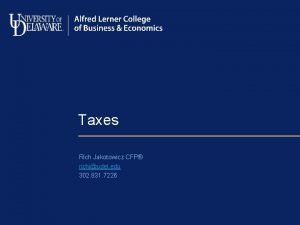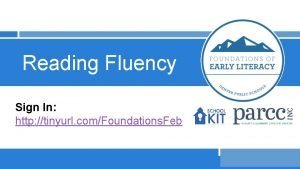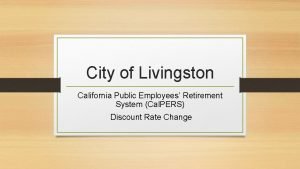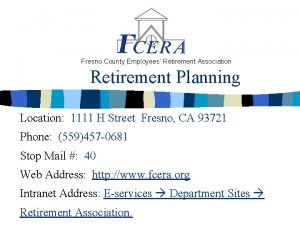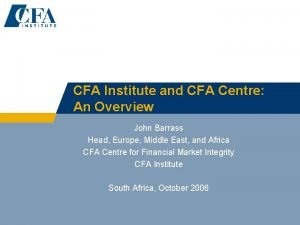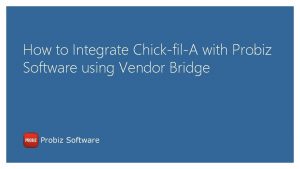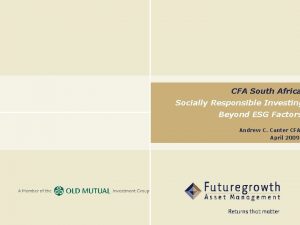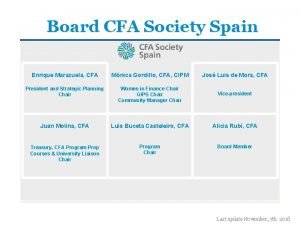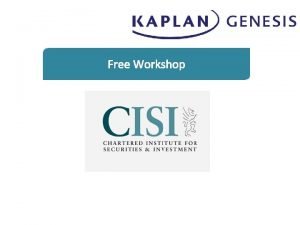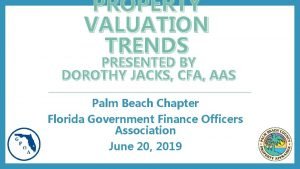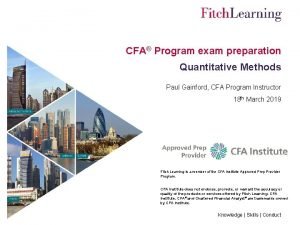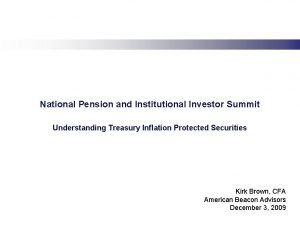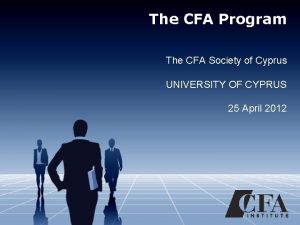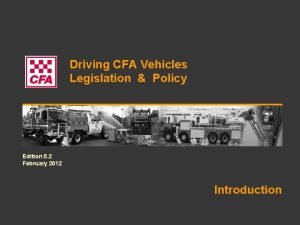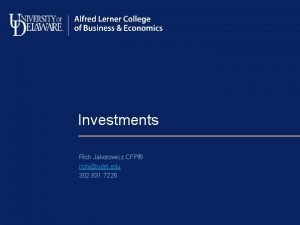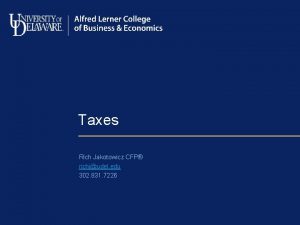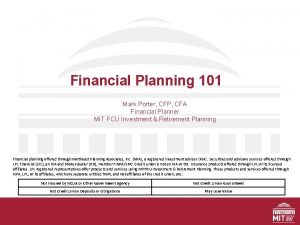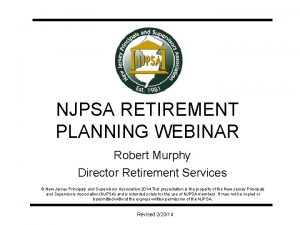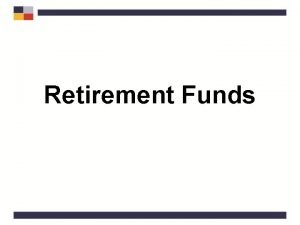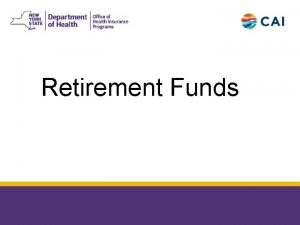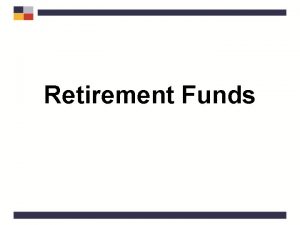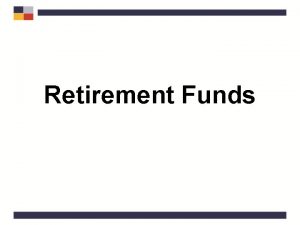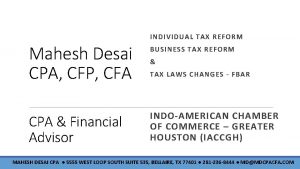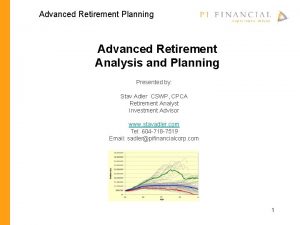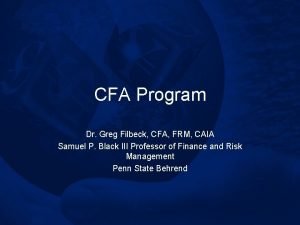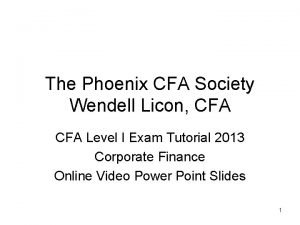Retirement Planning Richard Jakotowicz CFA CFP Director of





































- Slides: 37

Retirement Planning Richard Jakotowicz CFA, CFP® Director of the Financial Planning & Wealth Management Major Purnell Hall, Room 318 302 -831 -7226 | richj@udel. edu 1

Total Control Asset Allocation, Location, & Dedication Market Returns Saving vs Spending Retirement Policy regarding Taxes, Benefits, and Savings Employment, Earnings, and Duration Longevity Some Control Out Of Your Control

Retirement Plans Are Different Today 403 b plans 401 k plans Pension Plans Source: The BIS and shows how since the 1980’s companies have stopped offering traditional pensions (defined benefit plans – the blue line) and instead started offering retirement accounts such as 401 K’s (defined contribution plans – the red line).

We Are Living Longer! If you’re 65 today, the probability of living to a specific age or beyond

Many Individuals Retire Earlier Than They Planned Expected vs Actual Retirement at 65 Reasons cited for retiring earlier than planned Source: Employee Benefit Research Institute, Mathew Greenwald & Associates, Inc. , 2016 Retirement Confidence Survey. Data as of March 2016.

Misconceptions from the “Old World” can cause harm to you in the “New World. ”

Focusing on investments is not enough You need an income and spending plan!

Average Spending Patterns By Age Group

Understanding Inflation

Understanding Inflation & Returns Your Investment Return Your Investments Need To Earn A Higher Return Than Inflation!

Older Individuals Experience Higher Rates Of Inflation Source: BLS, Consumer Price Index, JP Morgan Asset Management, Data represents the annual percentage increase from 1981 through 2016 except for entertainment and education which date back to 1993. Personal care products includes tobacco.

Where Will Your Income Come From During Retirement

Social Security Benefits – Early, FRA, or Delayed Source: Social Security Administration, JPMAM

Breakeven Ages Source: Social Security Administration, JPMAM

Where Will Your Income Come From During Retirement There are 3 common strategies for creating retirement income: 1. Systematic Withdrawals 2. Income Flooring 3. Bucketing or Goals Based Investing

Option 1: Systematic Withdrawals Sell and Withdrawal a certain percentage of your retirement account each year 4% Withdrawal Rate = $40, 000 5% Withdrawal Rate = $50, 000 Bonds $400, 000 Stocks [VALUE]

Effects Of Withdrawal Rates & Allocations Years of sustainable withdrawals for a portfolio earning average returns Projected nominal outcomes, 50 th percentile 40/60 Portfolio © 2017 Emerging Advisor, LLC 4% Withdrawal Rate

Systematic Withdrawals Pros Cons • The more you’ve saved and invested, and the more you’ve controlled your expenses, the less risk you will incur by taking the small annual withdrawals needed to support your lifestyle, and the more risk you can take with your portfolio and unknown future returns. • If the portfolio isn’t large enough, it may not provide enough cash to support your lifestyle at a “safe” withdrawal rate of 4%, tempting you to withdraw more and deplete the portfolio. • You determine what percentage you could safely withdrawal each year without risk of running out of money. • Even a large portfolio can be depleted by an unlucky sequence of poor returns in the market. • If the market is declining you will need to withdraw considerably less income. © 2017 Emerging Advisor, LLC

Option 2: Create An Income Floor Requires you to convert part of your 403 b into a lifetime annuity to eliminate the risk of outliving your savings. Discretionary Expenses - your “Wants” $ Essential Expenses - your “Needs” 403 b, Investments Annuity Social Security Time © 2017 Emerging Advisor, LLC Guaranteed Income

Option 2: Income Flooring Pros Cons • Involves converting a portion of your money to an annuity that secures your essential living expenses. • In the current low interest rate world, annuities are expensive meaning the future payments you will receive will be low. • The success of your retirement is not at the mercy of the market. • An immediate annuity strategy may not provide inheritance. • Tries to protect your income, not score a few extra points in the market. © 2017 Emerging Advisor, LLC

Option 3: Goals Based Investing • • • Stocks Real Estate Alternative Investments Wants • • Stocks Corporate Bonds Needs • • Social Security Pension Government Bonds Cash / Money Market Legacy

Option 3: Bucketing 15+ Year Horizon 5 -15 Year Horizon 0 -5 Year Horizon Low Risk • Money Market • High Quality Bond Ladder Moderate Risk High Risk • 80% Stock • 20% Bonds • 50% Stock • 50% Bonds Each year a decision must be made to move money from long-term buckets to short-term buckets The allocations shown above are for illustrative purposes only. Each investor has a different tolerance for time horizon and risk.

How Does A $50, 000 Bond Ladder Work TODAY 5 Year Bonds 4 Year Bonds 3 Year Bonds 2 Year Bonds 1 YEAR LATER $10, 000 $10, 000 4 Year Bonds 3 Year Bonds 2 Year Bonds 1 Year Bonds Cash © 2017 Emerging Advisor, LLC $10, 000 $10, 000

Option 3: Bucketing Pros Cons • Intuitive and easy to understand. Retirees may benefit from using a Bucket Strategy to conceptualize retirement income. • In the current low-yield world, bucketing is expensive in buckets #1 and #2. • Asset dedication makes it easier to withstand the temptation to sell out during a loss at market bottoms. • Requires a “rule” for moving money between buckets • You will know how much money you will receive in any given year. • Bucketing is geared towards high levels of income, not high levels of growth. • Inheritance to beneficiaries is possible. © 2017 Emerging Advisor, LLC

Sequence Of Return Risk

Year S&P 500 Performance 2000 -10. 14 2001 -13. 04 2002 -23. 37 2003 26. 38 2004 8. 99 2005 3. 00 2006 13. 62 2007 3. 53 2008 -38. 49 2009 23. 45 2010 12. 78 2011 0. 00 2012 13. 41 2013 29. 60 2014 11. 39 © 2017 Emerging Advisor, LLC Sequence Risk is the risk that you experience large negative returns during the early years of your retirement. The total annual returns shown above do not reflect any dividends paid or any stock spinoffs from original stock. Past performance is no guarantee of return or future performance.

Cumulative Principal Of Mathematics © 2017 Emerging Advisor, LLC

Same Returns BUT An Annual $20, 000 Withdrawal © 2017 Emerging Advisor, LLC Withdrawal occurs at beginning of the year and is adjusted for 3% inflation

Two Brothers Two (Different) Retirements • Two Brothers • $500, 000 each (IRA) at retirement • Both will use $30, 000 annually for income • Steve retires in 1990 • Bill retires in 2000 • The result? © 2017 Emerging Advisor, LLC

Two Brothers Two (Different) Retirements Bill Retired in 2000 Steve Retired in 1990 WD Balance Year Return 1990 -4. 34% $ 30, 000 $ 449, 602 2000 -6. 18% $ 30, 000 $ 440, 954 1991 20. 32% $ 30, 000 $ 504, 865 2001 -7. 10% $ 30, 000 $ 381, 776 1992 4. 17% $ 30, 000 $ 494, 667 2002 -16. 76% $ 30, 000 $ 292, 819 1993 13. 72% $ 30, 000 $ 528, 419 2003 25. 32% $ 30, 000 $ 329, 364 1994 2. 14% $ 30, 000 $ 509, 085 2004 3. 15% $ 30, 000 $ 308, 794 1995 33. 45% $ 30, 000 $ 639, 340 2005 -0. 61% $ 30, 000 $ 277, 094 1996 26. 01% $ 30, 000 $ 767, 829 2006 16. 29% $ 30, 000 $ 287, 345 1997 22. 64% $ 30, 000 $ 904, 873 2007 6. 43% $ 30, 000 $ 273, 892 1998 16. 10% $ 30, 000 $ 1, 015, 728 2008 -33. 84% $ 30, 000 $ 161, 359 1999 25. 22% $ 30, 000 $ 1, 234, 328 2009 18. 82% $ 30, 000 $ 156, 081 © 2017 Emerging Advisor, LLC Returns represent the performance of the Dow Jones Industrial Average

Sequence of Return Risk (retire at year 30) Mc. Lean Asset Management Corporation, 2016 Wade Pfau, Ph. D. , CFA

Last But Not Least TAXES!

Your 403 B Is Not ALL Yours When you withdrawal money from your 403 b, you must pay Federal and State (exceptions!) Income Taxes.

4% Withdrawal Rate Is Not 4% When you withdrawal money 4% from your 403 b, you don’t get 4%

Understanding Taxes 403 b, 401 k, IRA --- Withdrawals Are Taxed As Income Withdrawals Required Withdrawals Allowed 59 ½ AGE 70 ½ ROTH 403 b, ROTH 401 k, ROTH IRA --- Withdrawals Are Tax Free Withdrawals Allowed 59 ½ AGE

Each State Taxes Retirement Income Differently © 2017 Emerging Advisor, LLC

Total Control Asset Allocation, Location, & Dedication Market Returns Saving vs Spending Retirement Policy regarding Taxes, Benefits, and Savings Employment, Earnings, and Duration Longevity Some Control Out Of Your Control
 Rich jakotowicz
Rich jakotowicz Cfp lead generation
Cfp lead generation Tinyurl com/yudcp cfp
Tinyurl com/yudcp cfp Cfp saugo thiene
Cfp saugo thiene Cfp yfp
Cfp yfp Cfp pio xi
Cfp pio xi Cfp legnano
Cfp legnano Cfp yfp
Cfp yfp Anfh cfp
Anfh cfp Livingston federal employee retirement planning
Livingston federal employee retirement planning Retirement planning warsaw
Retirement planning warsaw Planning for retirement windsor
Planning for retirement windsor Keogh plan definition
Keogh plan definition Retirement planning fresno
Retirement planning fresno Looking for richard analysis
Looking for richard analysis Cfa contact
Cfa contact Probiz login
Probiz login Cfa lecturer handbook
Cfa lecturer handbook Cfa south africa
Cfa south africa Cfa institute españa
Cfa institute españa Cfa society pittsburgh
Cfa society pittsburgh Cfa society minnesota
Cfa society minnesota Bsk koppen climate
Bsk koppen climate Aktutor.in mcq
Aktutor.in mcq Chalk and board cfa
Chalk and board cfa Icfa restauration
Icfa restauration Dorothy jacks
Dorothy jacks Cfa humid subtropical
Cfa humid subtropical Chebyshev inequality cfa
Chebyshev inequality cfa Treasury inflation protected securities cfa
Treasury inflation protected securities cfa Cfa society austin
Cfa society austin Cfa research challenge 2018
Cfa research challenge 2018 Mouvement panafricain de rejet du franc cfa
Mouvement panafricain de rejet du franc cfa Cfa cyprus
Cfa cyprus Cfa society czech republic
Cfa society czech republic Mplus syntax
Mplus syntax Cfa institute esg intergation
Cfa institute esg intergation Cfa code 3
Cfa code 3
